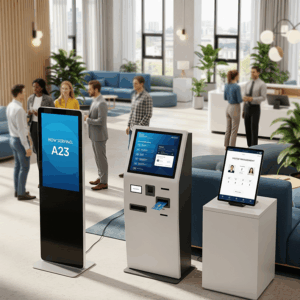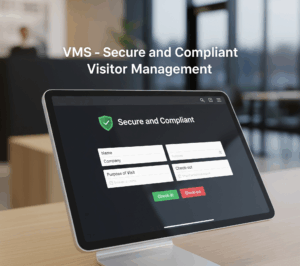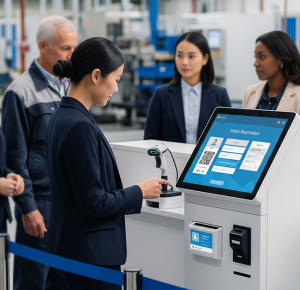
News & Updates

How to Implement a Contactless Visitor Management System
Modern organisations face increasing pressure to balance security, efficiency, and user experience at entry points. Implementing a contactless visitor management system has become essential for businesses seeking to modernise their operations while maintaining strict access controls. The shift towards touchless interactions isn’t just about health considerations it’s about creating streamlined, professional visitor experiences that reflect an organisation’s commitment to innovation and operational excellence.
ATT’s Visitor Management System (VMS) transforms traditional front-desk processes through automated registration, real-time tracking, and comprehensive security analytics. This sophisticated platform eliminates manual paperwork, reduces staff workload, and provides unprecedented visibility into visitor activity while maintaining the highest security standards. From initial check-in to departure tracking, VMS creates a seamless digital journey that enhances both security protocols and visitor satisfaction.
This implementation guide explores the critical steps, considerations, and best practices for deploying a contactless visitor management solution that meets organisational needs while ensuring compliance and operational excellence. Whether you’re managing a corporate office, healthcare facility, or government building, the principles and processes outlined here will help you navigate the implementation journey successfully and achieve measurable improvements in security, efficiency, and visitor experience.
Assess Your Current Visitor Processing Requirements
Before implementing any contactless visitor management system, organisations must conduct a thorough assessment of their existing processes, security requirements, and operational constraints. This foundational step determines the scope, features, and integration needs of your new system. A comprehensive assessment involves documenting current workflows, identifying bottlenecks, and understanding the specific challenges your organisation faces in managing visitor access. This analysis provides the baseline against which you’ll measure improvement and helps justify the investment in new technology.
Understanding current pain points, visitor volumes, and compliance requirements ensures that your contactless solution addresses real business challenges while delivering measurable improvements in efficiency and security. Many organisations discover that their manual processes are not only time-consuming but also create security vulnerabilities and compliance gaps.
By thoroughly documenting existing procedures, you’ll be better positioned to design a contactless system that eliminates these weaknesses while preserving the positive aspects of your current approach. This assessment phase typically reveals opportunities for automation that extend well beyond simple visitor registration.
Analyze Visitor Traffic Patterns and Peak Periods
Document your organisation’s visitor patterns including daily, weekly, and seasonal fluctuations to size your system appropriately. Track average processing times, peak hour volumes, and staff resource allocation during busy periods. This data collection should span several weeks to capture typical variations and identify recurring patterns that will inform your system design. Understanding these patterns helps determine the number of kiosks, processing capacity, and staffing adjustments needed for smooth implementation.
Organisations typically see 40-60% efficiency gains when systems are sized correctly based on actual traffic analysis. This improvement comes from eliminating manual data entry, reducing wait times through automated processing, and optimising staff deployment based on predictable traffic patterns. The data you collect during this phase will also help you establish baseline performance metrics that you can use to measure the success of your implementation.
Identify Security and Compliance Requirements
Map out specific security protocols, data protection requirements, and regulatory compliance needs that your visitor management system must support. This mapping exercise should involve key stakeholders from security, compliance, and legal teams to ensure all requirements are properly identified and documented.
Document authentication methods, visitor screening processes, and audit trail requirements to ensure your contactless solution maintains or exceeds current security standards. Understanding these requirements early in the process helps avoid costly redesigns later and ensures that your new system will pass security audits and compliance reviews. This assessment should also consider future regulatory changes that might affect your visitor management processes.
Design Your Contactless Registration Workflow
Creating an intuitive, secure, and efficient contactless registration workflow is central to successful implementation. This involves mapping the complete visitor journey from pre-arrival to departure, incorporating self-service touchpoints, automated verification processes, and seamless integration with existing security systems. The workflow design must balance user convenience with security requirements, ensuring that the contactless experience doesn’t compromise safety or compliance standards.
A well-designed workflow reduces processing time, minimises staff intervention, and delivers a professional first impression while maintaining comprehensive security controls. The key is to automate routine tasks while preserving human oversight for exceptions and special circumstances. Your workflow should accommodate different visitor types from regular contractors to first-time guests while maintaining consistent security protocols and user experience standards across all scenarios.
Pre-Registration and Appointment Integration
Enable visitors to complete registration online before arrival through web portals or mobile applications. Integration with appointment systems allows automatic visitor verification and reduces on-site processing time. This pre-registration capability transforms the arrival experience from a lengthy check-in process to a simple verification step, dramatically reducing queues and improving visitor satisfaction.
Pre-registration captures essential information, validates visitor credentials, and enables host notifications, creating a streamlined arrival experience that supports social distancing and operational efficiency. The system can verify visitor details against security databases, check appointment validity, and even conduct preliminary security screenings before the visitor arrives on-site, making the physical check-in process virtually instantaneous.
Self-Service Kiosk Configuration
Configure kiosks to guide visitors through registration steps using clear instructions, multilingual support, and accessibility features. Include document scanning, photo capture, and digital signature capabilities while ensuring the interface remains user- friendly. The kiosk interface should be intuitive enough for first-time users while efficient enough for regular visitors, balancing simplicity with comprehensive functionality.
Kiosks should connect to backend systems for real-time verification and badge printing, creating a fully autonomous registration process. This integration enables immediate background checks, validates visitor credentials against security databases, and produces professional visitor badges with appropriate access permissions. The kiosk configuration should also support different visitor categories with customised workflows that match their specific requirements and security clearance levels.
Automated Host Notification and Approval Workflows
Implement automated notification systems that alert hosts when visitors arrive and require approval. Configure approval workflows based on visitor types, security clearance levels, and organisational policies. These workflows can route approval requests to the appropriate personnel automatically, ensuring that sensitive visits receive proper authorisation while routine visits proceed without delay.
This automation reduces reception desk workload while maintaining proper authorisation controls and creating digital audit trails for compliance purposes. The system can escalate approval requests when hosts don’t respond within specified timeframes, ensuring that visitors aren’t left waiting indefinitely. These automated workflows also maintain detailed logs of all approval decisions, supporting compliance reporting and security audits.
Implement Data Security and Privacy Controls
Data security and privacy protection are fundamental requirements for any visitor management system, particularly when handling personal information and maintaining compliance with regulations. Implementation must include encryption protocols, secure data storage, access controls, and audit capabilities. The security framework must protect visitor data throughout its lifecycle from collection and processing to storage and eventual deletion while maintaining system performance and user experience.
Organisations must establish clear data retention policies, user access management, and incident response procedures to protect visitor information while supporting operational transparency and regulatory compliance requirements. The security implementation should anticipate potential threats and include multiple layers of protection to ensure that visitor data remains secure even if individual security measures are compromised. This comprehensive approach to security builds trust with visitors and demonstrates organisational commitment to privacy protection.
Encryption and Secure Data Transmission
Implement end-to-end encryption for all data transmission between kiosks, servers, and integrated systems. Use industry-standard encryption protocols for database storage and ensure secure communication channels for all system components. This encryption framework should protect data both in transit and at rest, preventing unauthorised access even if network traffic is intercepted or storage devices are compromised.
Regular security updates and vulnerability assessments help maintain protection against emerging threats while preserving system performance and user experience. The encryption implementation should be transparent to users while providing robust protection that meets or exceeds industry standards and regulatory requirements.
Role-Based Access Controls and Audit Trails
Configure granular access controls that limit system access based on user roles and responsibilities. Implement comprehensive audit logging that tracks all system interactions, data access, and administrative changes. These controls ensure that personnel can only access the information and functions necessary for their roles, reducing the risk of data breaches and supporting compliance with privacy regulations.
These controls support compliance requirements while providing clear accountability and enabling rapid incident investigation when security issues arise. The audit trail capabilities should capture sufficient detail to support forensic analysis while maintaining system performance and user privacy. Regular review of access logs helps identify unusual activity patterns and supports continuous improvement of security protocols.
Train Staff and Establish Support Procedures
Successful implementation requires comprehensive staff training and clear support procedures to ensure smooth daily operations. Training should cover system operation, troubleshooting common issues, visitor assistance, and emergency procedures. The training programme must address different staff roles and responsibilities, from reception personnel who interact with the system daily to security staff who monitor visitor activity and IT personnel who maintain system infrastructure.
Staff confidence in the new system directly impacts visitor experience and operational efficiency. Well-trained personnel can guide visitors through the registration process, resolve technical issues quickly, and maintain security protocols effectively. The training programme should include both initial implementation training and ongoing education to keep staff current with system updates and best practices. This investment in human resources ensures that your technological investment delivers maximum value.
Establishing clear escalation paths, maintenance schedules, and performance monitoring helps maintain system reliability while ensuring staff confidence in supporting the new contactless processes. Well-trained staff can maximise system benefits while providing excellent visitor experiences. The support procedures should cover both routine operations and exceptional circumstances, ensuring that staff can handle any situation professionally and efficiently.
Comprehensive Staff Training Programs
Develop training programmes covering system operation, visitor assistance, troubleshooting procedures, and emergency protocols. Include hands-on practice sessions and scenario-based training to build staff confidence. The training should simulate real-world situations that staff will encounter, from helping elderly visitors navigate the kiosk interface to managing system failures during peak visitor periods.
Provide ongoing training updates as system features expand or processes change, ensuring staff remain proficient and can deliver consistent support to visitors using the contactless system. This continuous education approach helps staff adapt to system improvements and maintains high service standards as technology evolves. Regular training refreshers also reinforce security protocols and compliance requirements.
Performance Monitoring and Continuous Improvement
Establish key performance indicators to monitor system effectiveness including processing times, user satisfaction, and error rates. Regular performance reviews help identify optimisation opportunities and support continuous improvement initiatives. These metrics should align with organisational objectives and provide actionable insights that drive system enhancements and process refinements.
Use visitor feedback and operational data to refine processes and enhance the contactless experience while maintaining security and compliance standards. This data-driven approach to improvement ensures that system changes address real user needs and operational challenges rather than perceived problems. Regular performance analysis also helps identify training needs and system configuration adjustments that can improve overall effectiveness.
Monitor Performance and Optimize Operations
Post-implementation success depends on continuous monitoring, performance analysis, and system optimisation. Organisations must track key metrics including visitor processing times, system uptime, user satisfaction scores, and security compliance measures. This ongoing monitoring provides early warning of potential issues and helps maintain optimal system performance as visitor volumes and organisational needs evolve.
Regular performance reviews enable proactive system adjustments and help identify opportunities for workflow improvements. This ongoing optimisation ensures that your contactless visitor management system continues delivering value while adapting to changing organisational needs and visitor expectations. The monitoring framework should balance automated alerts with regular human analysis to ensure that both immediate issues and long-term trends receive appropriate attention.
Real-Time Dashboard Monitoring
Utilise system dashboards to monitor visitor volumes, processing times, and system performance in real-time. Set up automated alerts for system issues, high traffic periods, or security incidents to enable prompt response. These dashboards should provide at-a-glance visibility into system health and operational metrics, enabling proactive management rather than reactive problem- solving.
Real-time monitoring helps maintain optimal performance while providing data for capacity planning and resource allocation decisions. The dashboard configuration should be customisable to different user roles, ensuring that reception staff, security personnel, and IT administrators each receive the information most relevant to their responsibilities. This targeted approach to information display improves decision-making efficiency and reduces information overload.
Regular System Updates and Feature Enhancements
Maintain regular update schedules for software patches, security improvements, and feature enhancements. Plan for system scalability and integration with new technologies as organisational needs evolve. The update process should be carefully managed to minimise operational disruption while ensuring that security vulnerabilities are addressed promptly and new capabilities are deployed effectively.
Regular updates ensure optimal performance, security compliance, and access to new capabilities that can further improve visitor experience and operational efficiency. The update planning should consider both immediate operational needs and long- term strategic objectives, ensuring that system evolution supports organisational growth and changing requirements. This forward-thinking approach to system maintenance protects the technology investment while maximising its operational value.
Implementing a contactless visitor management system transforms organisational security and operational efficiency while meeting modern expectations for digital, touchless experiences. The journey from assessment through optimisation requires careful planning, stakeholder engagement, and commitment to continuous improvement. When executed properly, contactless visitor management delivers measurable benefits in processing efficiency, security compliance, and visitor satisfaction while reducing operational costs and staff workload.
ATT’s Visitor Management System provides the foundation for secure, compliant, and user-friendly visitor processing that scales with organisational growth. Our comprehensive platform combines advanced technology with practical implementation support, ensuring that your contactless visitor management system delivers lasting value and operational excellence. The investment in modern visitor management technology positions your organisation as forward-thinking while providing tangible improvements in daily operations.
Contact our team at infosoft-sales@attsystemsgroup.com to discuss your contactless visitor management implementation requirements and discover how our proven solutions can enhance your facility’s security and visitor experience. Our experienced implementation specialists will work with you to design and deploy a system that meets your unique requirements while delivering the efficiency and security benefits that modern organisations demand.
Frequently Asked Questions
Q: What are the most important steps when transitioning to a contactless visitor management system?
A: Start by assessing your current processes, then design a digital workflow, select compatible hardware, implement robust data security, and train staff for smooth adoption.
Q: How does a contactless system improve security and compliance compared to manual visitor registration?
A: Contactless systems automate authentication, maintain digital audit trails, and enforce consistent compliance protocols, reducing human error and gaps in security.
Q: Can ATT’s Visitor Management System integrate with existing building access control and security platforms?
A: Yes, ATT’s VMS is designed for seamless integration with access control, cameras, and management platforms for unified security and efficient visitor tracking.
Q: What are the key hardware considerations for contactless visitor management kiosks?
A: Prioritize kiosk placement for visibility and accessibility, ensure compatibility with badge printers and scanners, and meet accessibility standards for all users.
Q: How can organizations ensure visitor data privacy and security during and after check-in?
A: Use end-to-end encryption, role-based access controls, and clear data retention policies to protect visitor information throughout its lifecycle.
Q: What ongoing actions help optimize a contactless visitor management system after launch?
A: Monitor real-time performance metrics, collect user feedback, and schedule regular software updates to maintain efficiency and security.
Q: How should staff be trained to support a new contactless visitor management system?
A: Provide hands-on system training, scenario-based practice, and regular updates to ensure staff can confidently assist visitors and troubleshoot issues.
Send us a message
Contact Information
Address:
35 Ubi Crescent, ATT Building, Singapore, 408585
Phone:
Email:
Website:
www.attsystemsgroup.com





